or…“Why on earth would I do it myself?”
Cooking is my principle joy in life, so the idea of “picking up a rotisserie chicken” on the way home never crosses my mind. I’m pretty much DIY, if you hadn’t noticed. My son Carter, on the other hand, has long appreciated the value of picking up a cooked bird, as his time is always limited, his motivation often directed at pursuits other than cooking, and his need for protein occasionally urgent. Here is a little “compare and contrast” on the topic.
Various stores offer roasted or rotisserie chickens at various prices. If a grocery store has the facilities to process food, unsold raw chickens that are reaching their “sell before” date can have their saleability extended by cooking them. The store can afford to sell the cooked birds at a reasonable price, because they were headed for the garbage bin otherwise, a zero return on the store’s investment. Cooking extends the shelf-life of the bird – it can be sold whole or in pieces on the day it’s roasted, from morning to evening, if held at food-safe temperatures. After that, it can be cooled and stripped and turned into chicken salad or whatever, further extending its sale-ability for another day or two. It makes good economic sense for both the store and the consumer – less waste for the store, safe use of inventory, and a good deal for the diner.
A nice little chicken should provide at least four meals, and some soup stock (unless you are young and an athlete, and your need for protein is urgent – then it’s a meal and maybe a snack). So I bought a bird from my local grocery store.


2 pounds and 3 ounces of goodness for $9.99
I broke it down into the two skinned breasts, and the two leg/thigh quarters. For most folks, this would be four quarter-chicken meals

That gave me six and a half ounces of dark meat, 5 and a half ounces of white per portion
I don’t enjoy gnawing meat off the bone, so I stripped the leg and thigh meat.
I reserved all the bones, the wings, and the skin (I don’t eat the skin, but it’s full of flavor) for future stock-making. I chose one breast portion for my dinner, so I could taste it at its peak of perfection. Everything else was packaged and refrigerated immediately: the dark meat and the bones went straight to the freezer.




From the same store, I bought a raw chicken that looked about the same size as the cooked bird, so that I could compare a home-roasted bird with the rotisserie one. At $8.29, it was cheaper than a pre-cooked bird, but if you factor in my costs of cooking it at home, the value is pretty close.
It had no giblets or neck in its cavities, and had been trussed just like my pre-cooked chicken, so clearly it had been packaged for the convenience of the home-cook, or maybe so it go directly onto the spit if it didn’t sell in a timely manner. Even the wings had been folded under, saving me from my least favorite part of chicken preparation – twisting its little arms so it will sit nicely on the roasting rack. I always feel like such a torturer when I do that.

In the interest of fairness, I treated the bird very simply, tossing a couple of shallots into its interior, sprinkling it inside with “poultry seasoning”, which contains ground sage, thyme and rosemary. I often brine whatever form of chicken I am roasting, but in this instance I didn’t. Some frozen chicken (particularly boneless, skinless breasts) comes pre-brined from the packaging plant — look for the word “enhanced” on the lable.
Outside I painted it with canola oil and sprinkled it with seasoning salt. I had removed the trussing string to look for giblets, so I re-tied its little legs together.




I cooked it on a rack over a baking pan using Michael Smith’s protocol – oven heated to 500°F, bird in, temperature immediately reduced to 350°F, total cooking time about 1 hour and 20 minutes. The whole house smelled like Thanksgiving!
My finished bird weight in at 2 pounds, 10 ounces.

A fully roasted chicken should sit under a foil tent for 30 minutes before carving, or all the juice in the meat will run out all over the carving board. Even after a 30 minute rest, my little home-roasted chicken released plenty of juice when I started to break it down, which made the final weight more in keeping with the rotisserie bird. My rotisserie bird was certainly well rested – I think it came off the spit at noon, and I bought it at 4pm. No release of juice at all when I broke it down.


I broke my home-roasted bird down exactly the same way.
I saved those released juices and added them to the pot when I made chicken stock from all the bones and skin. Because the skin had browned beautifully from both the rotisserie roasting and my own oven roasting, the resulting stock was very rich and brown. I turned it into the most delicious gravy.
The pieces were almost exactly the same weight as the rotisserie chicken.




So, at the end of the day, was there a huge difference between the rotisserie chicken and my own home-roasted chicken? Not really.
My home-roasted bird was significantly more moist, probably because it hadn’t been sitting in its cooked state for so long, or maybe because I cooked it only as long as I absolutely had to in order to achieve an internal temperature of 180°F at the thickest point of the thigh meat. Maybe rotisserie birds experience more evaporation during cooking. It was a little more difficult to remove the meat from the bones of my home-roasted bird, again probably because it hadn’t been “resting” as long. The store-roasted chicken certainly tasted like chicken, although it was pretty “Plain Jane” with its skin removed. I kept my home-roasted bird equally plain, and the results were similar. It would only have taken me an extra 10 minutes to “kick it up a notch” flavor-wise, though, with very little added cost. Of course, my home-roasted bird did take time and energy to prepare, not to mention the clean up afterwards.
Could there have been a huge difference in quality? Absolutely!
If you roast your own bird, you have lots of opportunities to enhance its flavor. You can start by choosing a larger (older) bird, or an organic one, or one from the farmers market that might have been raised in a way that would make it more flavorful. On the downside, it’s going to be more expensive. From the preparation point of view, you could brine your chicken – it’s not hard, and it can make a big difference. At the least, you could season the bird under it’s skin. Chicken skin is like a raincoat – not much makes it through into the flesh. Many recipes suggest gently separating the skin from the flesh and spreading a paste of butter and herbs right onto the breast meat, a practice I heartily endorse. You can stuff the cavity of the bird with fresh herbs, onion, garlic, lemons, all of which enhance the flavor of the roasted meat.
Each of my birds gave me:
One “Winner Winner Chicken Dinner” (You really should visit me on recipe-testing day….)
one really great sliced chicken sandwich (This was epic — Guacamole spread on a toasted grainy bagel, lettuce, bacon, chicken, tomatoes, a little s&p)
one terrific lunch of “lettuce wraps” (This recipe has been posted before..)
and three chicken pot pies per bird from the dark meat, using the remaining gravy I made from the chicken stock,




Economically? Store-roasted chickens are a heck of a deal. Really! The value of the rotisserie chicken to the solo diner is clear – it’s a great choice if you choose and use it wisely. Make sure it has been held at food-safe temperature before you buy (HOT, not just warm), break it down immediately upon getting home, and try not to eat the whole thing in one sitting. Freeze what you aren’t going to eat within 3 days.
Me? I think I will continue to roast my own, especially now that I have access to locally raised, free-range birds (thanks, Carmaine!) I don’t mind the expense, or the time and trouble, because I value the outcome. I’ll choose flavor over convenience for my special occasion birds, and let Carter enjoy his “instant dinner” whenever he wants it!



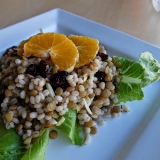
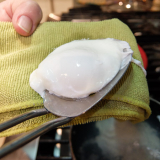
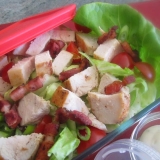

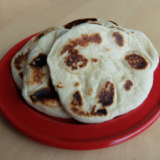
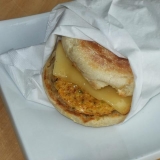
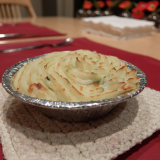
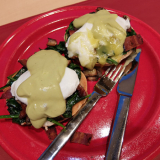

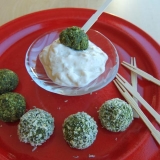

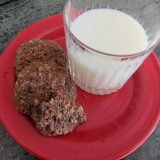
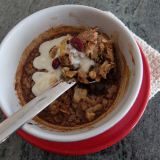
Leave A Comment